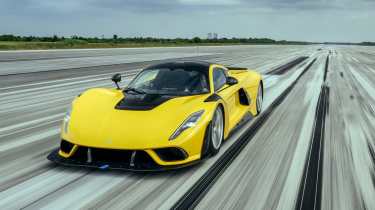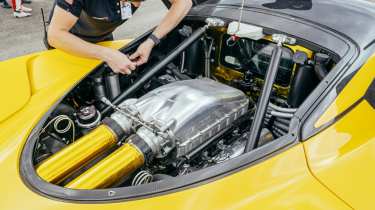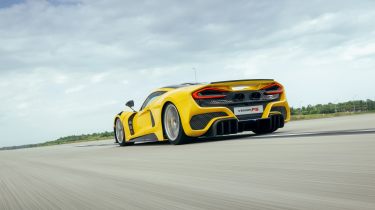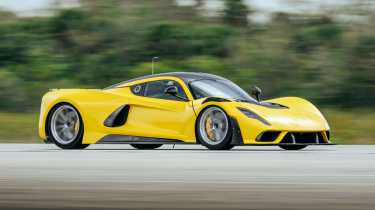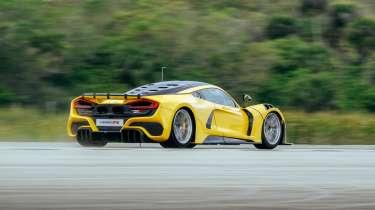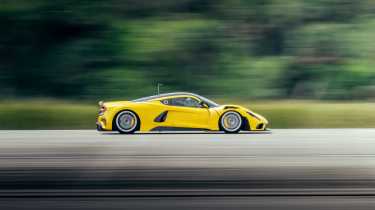Hennessey Venom F5 Evolution 2025 review - driving one of the world’s fastest cars
We visit America for some speed record testing in the 2031bhp Texan titan aiming for over 300mph
Hennessey know Kennedy Space Center’s Shuttle Landing Facility well. In fact, it’s become something of a home from home. The fastest hypercars need a safe space in which to stretch their legs. Especially when they are in their development phase. Just as there are no old, bold pilots, testing production street cars with a 300mph capability like the 2031bhp £2.21million Venom F5 Evolution isn’t a case of licking the stamp and sending it.
We join the HSV crew at a pivotal stage in the Venom F5’s journey towards the triple ton. Since production car development began in 2021, the F5 has been pushed progressively harder and faster, but the chase for a world record speed can’t be hurried. Especially when you’re balancing the desire to shoot for the stars against the need to build and deliver cars to fulfil customer orders.
Hennessey buyers love the brand’s obsession with speed. It’s part of the company’s DNA. So, while the Venom F5 has been billed as a 300mph machine from the very beginning, John Hennessey has always been up-front about the challenges of getting the car to that epic number and the time it may take to get there.
Everyone believes it will get there. And it’s a mark of the F5’s appeal that customers haven’t waited for it to hit 300 before placing their order. Still, speaking to John Hennessey, it’s clear he wants to get the job done. To this end he has continued to expand the HSV team. And as the in-house brains trust grows, so the F5 has progressed and developed, now reaching the stage where so many improvements have been made to the powertrain, chassis and aerodynamics that the car has morphed into the new F5 Evolution.
Much has changed but the fundamentals remain the same. That’s to say Hennessey’s bespoke carbon structure and sleek design fused with the shock and awe of the company’s equally bespoke 6.6-litre ‘Fury’ V8, which has benefitted from Ilmor Engineering’s forensic analysis and extensive improvement.
More reviews
Ilmor’s knowledge of pushrod engines is second-to-none, having developed a Mercedes-badged V8 specifically for Penske’s 1994 Indy 500 assault. Known as ‘The Beast’, this 3.4-litre turbocharged 16-valve engine developed more than 1000bhp and dominated the race, Al Unser Jnr finishing a lap ahead of the second-place car. Turning its attentions to the F5’s engine, Ilmor pursued gains in performance, durability and drivability through a deep-dive analysis, dyno testing, and Spintron testing of valvetrain dynamics, friction and component behaviour, followed by a 25,000-mile extreme test-rig programme.
These tests informed new pistons, designed and machined in-house at Ilmor, plus fine-tuning of the valvetrain. The results are quite extraordinary, the regular F5 engine gaining 214bhp. To spare you the math, the F5 Evo now has 2031bhp at 8000rpm. Torque also swells from a gargantuan 1193lb ft at 5000rpm to a planet spinning 1445lb ft at 5200rpm. For context, that’s twice the power and torque of the Lamborghini Revuelto’s tri-electric-motor-assisted 6.5-litre V12, in a car that weighs 25 per cent less.
The Evolution also benefits from improved aero and the adoption of adaptive TracTive dampers in place of the original fixed-rate passive items fitted to earlier F5s. It’s the aero that requires the most dialling-in, and something the team are focusing on in this test session at NASA. A deeper front splitter, new front canards and vents in the tops of the front wings have yielded big gains in downforce, which then need to be matched by commensurate gains at the rear.
When you’re aiming to exceed 300mph, it’s the finest of balancing acts, those welcome gains in downforce needing to be consistent throughout a huge speed-range, and ideally drag-neutral to avoid impacting V-max capability. The test car is fitted with various test components, including trial Gurney flaps of varying heights to be tested at speeds well into the 200s to gauge their effectiveness.
> Inside Hennessey: How America's Bugatti fighter is built
Hennessey’s test and development driver is David Donohue. He’s been integral to the F5’s development programme from the start, and the wheelman for all its major landmark achievements to date. Quiet and analytical with vast experience, he’s a calm presence in Hennessey’s makeshift corral, watching from a shady perch as the HSV team make more adjustments before his next run.
‘This car ruins you for everything else,’ he says, in the manner of someone who is hooked on the hard stuff. ‘It just has so much performance. It just keeps going and going and going. When you’re running all day at a facility like this, you kind of get used to it, but then you hear yourself casually confirming the team’s instruction to complete a 250-0 run over the radio and you realise it’s actually crazy.’
I would normally avoid ‘son-of’ labels, but it’s worth noting that David’s father was an American racing legend, Mark Donohue. A consummate driver and instinctive engineer, he formed an extraordinary partnership with Roger Penske, which famously included development of the original twin-turbo monster: Porsche’s all-conquering 1500bhp 917/30 Can-Am racer.
Tragically, Mark was killed when David was just eight years old, succumbing to head injuries sustained during a practice session for the 1975 Austrian Grand Prix. There’s no doubt his father would have relished perfecting a car like the F5, which makes David’s lead role in its development and history-making both serendipitous and profound.
It’s always a risk committing to attend a live testing session. Especially when you’re there to ride and drive. Plans have a habit of changing, but true to their word the HSV team allow us access, starting with Donohue beckoning me over for a passenger ride. I’ve been in an F5 before, when I drove another example at the rather less sexy Millbrook Proving Ground in Bedfordshire, England. The cockpit is sparse but sleek. Much like the exterior, in fact. Being a development car, there’s test equipment mounted where my legs and feet would ideally sit, but it’s fine for a few runs up and down the runway. After all, they won’t take long.
You can’t see the opposite end of the runway from our start point. The most precisely laid concrete runway ever made seems to disappear into a silvery lake of heat shimmer at its midway point. Measuring 15,000ft (2.8 miles) long and 300ft wide, it was built specifically for the Space Shuttle programme. Between 1984 and 2011 some 78 landings were made here, culminating in Space Shuttle Atlantis returning to complete the programme’s final mission.
As such, this home of small steps and giant leaps is inspiring and yes, a little intimidating. Donohue remains reassuringly unfazed, pulling down on his shoulder harness one last time before twisting the steering wheel’s small central manettino to F5 mode for the full 2000+bhp experience. Gently feeding in the throttle before short-shifting into second gear, we are running at a steady 30mph. Then he guns it and everything goes a bit fuzzy at the edges.
I’ve driven and been driven in countless fast cars. Consequently my internal organs have an extensive databank of g readings to refer to for context. Of those, my previous experience of the F5 tops the charts, with the Pininfarina Battista in second and the Venom GT claiming the last podium slot. It takes less than ten seconds to conclude that the F5 Evolution is my new benchmark.
Mic’d up and with onboard cameras rolling, I try to read off the speed in 10mph increments but the numbers are increasing so fast its futile. Even 20mph increments pass in the time it take me to utter the words: ‘Hundred-and-fifty-hundred-and-seventy-hundred-and-ninety-two-ten-two-twenty…’ I sound like a bid-calling auctioneer at a Texan cattle sale, only my fill words are a little spicier.
When my turn comes to drive, Donohue politely vacates the cockpit and leaves me to it. Sensible man. Though to be honest there’s no chance of me attempting anything stupid. The car has already proved its point and I don’t want to be the one to fire it off into the alligator-infested swamp that lines the endless swathe of runway.
Donohue cautions me about the car being very ‘on the nose’ as they’re still working through the aero changes. He’s not kidding, but it’s fascinating to gain a feel for the car he was happily gunning well into the 200s just moments ago.
Strapped into the F5’s capsule-like cockpit, you get a perfectly framed view down the runway. The yoke suits the car perfectly, especially here, where major steering inputs only come at each end. The whole car pulses with energy, the Fury V8 throbbing at idle as the distinctive sweet aroma of burnt E85 fuel tickles my olfactory system.
Considering the torque it’s handling, the CIMA single-clutch transmission is surprisingly refined. There’s no need to pull away abruptly, so you just ease off the line, short-shifting like Donohue and engaging dusty muscle memory to massage the upshift to second as you would in something like an E46 CSL.
Big speeds demand small inputs, so you have to calm yourself down even as your adrenal glands start pumping like they’re feeding a Top Fuel dragster. There really is no adequate way to describe how the F5 feels at full-throttle in a low gear. Nor the way it devours successive ratios with unabated intensity. It’s brain-scramblingly explosive, but not in the manner of an EV hypercar. That’s largely to do with the soundtrack, but also the delivery. Colossal though the F5’s power and torque figures are, it still builds to a series of peaks in fine internal-combustion fashion, the momentary punctuation provided by each upshift sparing you the EV’s instantaneous assault with everything it has, followed by a gradual tailing-off.
Given we’re driving on a monolithic slab of perfectly level concrete, making a rollercoaster analogy might seem strange, but the F5’s ability to subject you to sustained longitudinal g creates the impression of freefall every time you pin the throttle. Equally extraordinary is how it manages to deploy such performance through the rear wheels alone. Of course, the traction control is managing things, but the intervention is minimal. Amusingly, during the test session the Bosch engineer present admits that the F5 Evo accelerates so rabidly they had to write some new software as it gains speed so fast it exceeded the parameters of the code.
To give you an idea of its capabilities, here are a few numbers extracted from a record-breaking standing half-mile speed run conducted by Donohue on this same runway early last year. Using Pilot Sport Cup 2 tyres, it did the standing quarter-mile in 9.5sec at 173mph and completed the half-mile sprint in 14.51sec at a speed of 221.92mph. In the process it accelerated from 100 to 200mph in just 6.48sec. That’s 2.2sec quicker than the Rimac Nevera.
For context, while the quarter-mile and half-mile times are slower than those of the Nevera (12.82sec for the half-mile) and Koenigsegg Jesko Absolut (14.0sec), the speed at the half-mile point is 15mph faster than the Nevera and 3.5mph faster than the Jesko. Oh, and 28mph faster than the Bugatti Chiron Super Sport.
John Hennessey revels in the long-standing rivalry that exists between his eponymous brand and that of fellow hypercar speed pioneers Christian Koenigsegg and Mate Rimac. It’s respectful. Encouraging, even. But be in no doubt, it matters.
At some stage this year – possibly in the next month or two – the HSV team will head to an as-yet undisclosed US runway facility and light the candle, entrusting David Donohue with keeping the Venom F5 Evolution’s throttle pinned for as long as he can. Then turn around and repeat the same feat in the opposite direction.
If the dream comes to pass, the barbed ‘H’ logo will then sit proudly on the nose of the world’s fastest car. Just how fast is anyone’s guess. Over to John Hennessey: ‘Topping 300mph and beating Bugatti with a two-way average are our primary objectives. But wouldn’t it be nice to also be the first to break the 500kph barrier while we’re at it?’ That’s 311mph…
There won’t be a sonic boom, but when the F5 finally achieves its goal, Hennessey’s holler will surely be heard for miles around.
